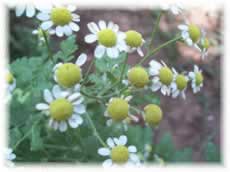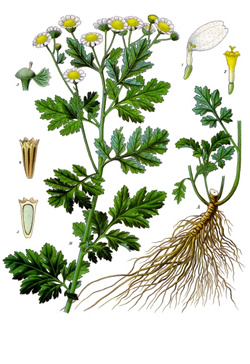Feverfew Tanacetum parthenium

- Common Names
- Feverfew
- Botanical Name
- Tanacetum parthenium
- Family
- ASTERACEAE
Medicinal Uses & Benefits of Feverfew
![]() How to Use|
Side Effects |
Plant & Garden|
How to Use|
Side Effects |
Plant & Garden|
- Medicinal Uses: * Allergies
* Headache/Migraine
* Insect Repellent
* Lupus
* Parasites/worms
- Properties: * Analgesic * Anti-inflammatory * Circulation * COX-2 Inhibitor * Febrifuge * Insect repellents
- Parts Used: arial parts
- Constituents: sesquiterpene lactones (including parthenolide and santamarine), volatile oil, tannins
How to Use: Feverfew
Feverfew inhibits platelet aggregating in the bloodstream, thus preventing blockage of small capillaries. This action is one of the reasons behind feverfew's popularity in treatment of migraines. It has a mild tranquilizing effect and is especially good for headaches caused by tension or fatigue. Feverfew has been used in the treatment of headaches since the first century. It has also been used for inflammation, arthritis, menstrual discomforts, fever, and other aches and pains.
Preparation Methods & Dosage :Dried and fresh herb, skin washes, tincture, capsules. Many feverfew products are standardized to a specific parthenolide content, but a holistic approach is to use the whole herb - the fresher the better. If you are not allergic to ragweed, this is a great herb to grow and use fresh. (It grows freely along my back garden fence) Unfortunately, many folks are allergic, and should always take feverfew in the form of encapsulated freeze-dried herb. Feverfew is a bitter herb for tea, and not one you would drink just for the pleasure. To prevent headaches chew 2 or 3 fresh leaves per day. To make a flea rinse for your pet, pour boiling water over the fresh herbs and let stand until completely cooled. Strain and apply wetting the fur and skin thoroughly. Do not towel dry or rinse.
Feverfew Remedies
Feverfew Side Effects: Avoid feverfew if you are allergic to plants in the ragweed family. The fresh leaves can cause mouth ulcers, discontinue use if this occurs . Not to be used while pregnant.
Plant Description

Koehler's Medicinal-Plants 1887
A relative of dandelions and marigolds, with diminutive daisy like flowers and fresh smelling leaves that act as a natural bee repellent.
Regional Traditions :European * North America *
How to Grow Feverfew
Perennial. Sun or part shade. Small daisy-like flowers. Sow seeds in spring or summer











